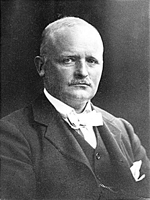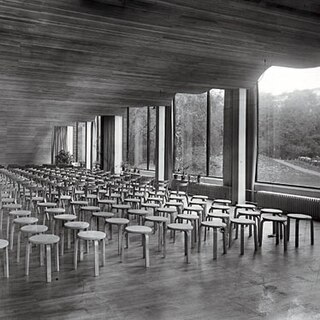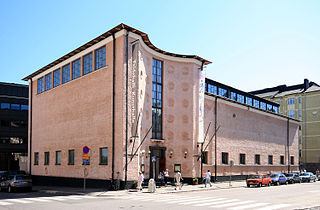
Hugo Alvar Henrik Aalto was a Finnish architect and designer. His work includes architecture, furniture, textiles and glassware, as well as sculptures and paintings. He never regarded himself as an artist, seeing painting and sculpture as "branches of the tree whose trunk is architecture." Aalto's early career ran in parallel with the rapid economic growth and industrialization of Finland during the first half of the 20th century. Many of his clients were industrialists, among them the Ahlström-Gullichsen family. The span of his career, from the 1920s to the 1970s, is reflected in the styles of his work, ranging from Nordic Classicism of the early work, to a rational International Style Modernism during the 1930s to a more organic modernist style from the 1940s onwards.

In architecture, functionalism is the principle that buildings should be designed based solely on their purpose and function.
The year 1991 in architecture involved some significant architectural events and new buildings.

Erik Gunnar Asplund was a Swedish architect, mostly known as a key representative of Nordic Classicism of the 1920s, and during the last decade of his life as a major proponent of the modernist style which made its breakthrough in Sweden at the Stockholm International Exhibition (1930). Asplund was professor of architecture at the Royal Institute of Technology from 1931. His appointment was marked by a lecture, later published under the title "Our architectonic concept of space." The Woodland Crematorium at Stockholm South Cemetery (1935-1940) is considered his finest work and one of the masterpieces of modern architecture.

Aino Maria Marsio-Aalto was a Finnish architect and a pioneer of Scandinavian design. She is known as a co-founder of the design company Artek and as a collaborator on its most well-known designs. As Artek's first artistic director, her creative output spanned textiles, lamps, glassware, and buildings. It has been discovered that it was Aino who completed the first work commissioned through Artek which was the Viipuri Library in 1935. Her work is in the MoMA's permanent collection and the MoMA has included her work in 9 exhibitions. Aino Aalto’s first exhibition was Art in Progress: 15th Anniversary Exhibitions: Design for Use at Museum of Modern Art (MoMA) in New York City, NY in 1944. Other major exhibitions were at Barbican Art Gallery in London and Chelsea space in London. Aino Aalto has been exhibited with Pablo Picasso.

Hack Kampmann was a Danish architect, Royal Inspector of Listed State Buildings in Jutland and professor at the architecture department of the Royal Danish Academy of Fine Arts. Marselisborg Palace in Aarhus, built between 1899 and 1902, is among his best known works.

Aarno Emil Ruusuvuori was a Finnish architect, professor and director of the Museum of Finnish Architecture. He studied at Helsinki University of Technology, completing his studies in 1951.

Uno Werner Ullberg was a famous Finnish architect.

Erik William Bryggman was a Finnish architect. He was born in Turku, the youngest of the five sons of Johan Ulrik Bryggman (1838–1911) and Wendla Gustava Bryggman (1852–1903). He began studies in architecture at Helsinki University of Technology in 1910 and qualifying as an architect in 1916. In 1914 he and fellow student Hilding Ekelund made a study trip to Denmark and Sweden. In 1920 he travelled to Italy, where he became inspired more by the local vernacular architecture than the classical or Baroque works. He worked in Helsinki for various architects, including Sigurd Frosterus, Armas Lindgren, Otto-Iivari Meurman and Valter Jung before starting his own office in Turku in 1923. Bryggman's architecture is noted for its combination of Nordic, classical and modernist characteristics.

Olari (Finnish) or Olars (Swedish) is a district of the city of Espoo, Finland. Olari is located about 15 kilometres west of central Helsinki, north of the Länsiväylä highway and Matinkylä. The district has a population of about 15,000. The population consist of mostly middle-class families. The district is famous for its contribution to the Finnish rap culture. One of the most notable landmarks of the district is Olari Church and Parish Centre, designed by architects Simo and Käpy Paavilainen, and completed in 1981.

Juha Ilmari Leiviskä is a prominent Finnish architect and designer. He is especially known for his churches and other sacral buildings.
Kristian Valter Alexander Gullichsen was a Finnish architect. The son of Harry and Maire Gullichsen, he was born into a family of industrialists, designers and artists. His siblings were the renowned Finnish philosopher Lilli Alanen and Johan Gullichsen, a professor of engineering. Kristian Gullichsen had three sons and two daughters, one of the sons was the artist Alvar Gullichsen. Gullichsen was married twice; his second wife was architect Kirsi Gullichsen.

Nordic Classicism was a style of architecture that briefly blossomed in the Nordic countries between 1910 and 1930.

The architecture of Finland has a history spanning over 800 years, and while up until the modern era the architecture was strongly influenced by currents from Finland's two respective neighbouring ruling nations Sweden and Russia, from the early 19th century onwards influences came directly from further afield: first when itinerant foreign architects took up positions in the country and then when the Finnish architect profession became established.

Jarl Gunnar Taucher, was a Finnish architect who first came to prominence in the first decades of the 20th century for his architecture designed in the style of Nordic Classicism, though later he turned to the Functionalist modernist style.

Allan Greenberg is an American architect and one of the leading classical architects of the twenty-first century, also known as New Classical Architecture.

Rainer Mahlamäki is a Finnish architect, president of the Finnish Association of Architects (SAFA) from 2007 to 2011, Professor of Contemporary Architecture at the University of Oulu, and joint partner with Ilmari Lahdelma of the Helsinki-based architecture firm Lahdelma & Mahlamäki Architects, one of the most prolific such firms in Finland. A significant part of their work started as entries in architectural competitions, in which they have received 35 first prizes.

Georg Hilding Ekelund was a Finnish architect, from 1950 to 1958 a professor of housing design at Helsinki University of Technology and from 1931 to 1934 editor-in-chief of the Finnish architects' journal Arkkitehti. His career as an architect spans the change in styles in Finland from the Nordic Classicism of the 1920s to the Modernism of the 1970s.

Pauli Ernesti Blomstedt, more commonly known as P. E. Blomstedt, was a Finnish architect and designer, who worked first in the Nordic Classicism style and then turned to Functionalism. Both his father, Yrjö Blomstedt, and younger brother, Aulis Blomstedt, were also well-known architects.

Gustaf Nyström was a Finnish architect. Nyström has been described as one of the most important architects in Finland at the end of the 19th century and the beginning of the 20th century. He was active both as an influential teacher, as an architect in his own right, and as an official involved in groundbreaking urban planning projects.




















